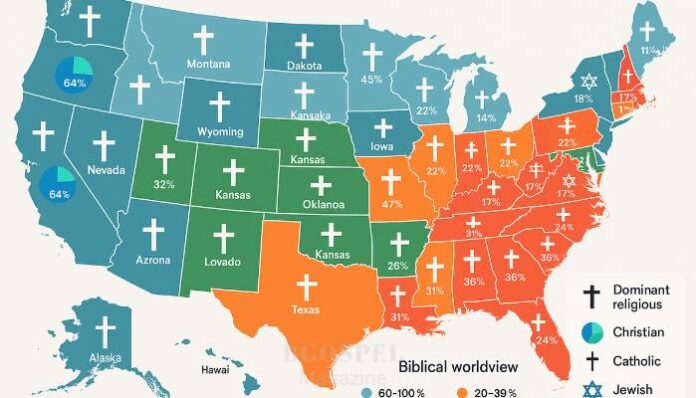The AWVI 2025 study: State analysis by state of the biblical vision of the world in America
The American WorldView Inventory 2025, led by Dr. George Barna of the Christian University of Arizona, presents the seventh report of an annual series which examines the vision of the world of American adults. This special edition analyzes the impact of the biblical vision of the world in each of the 50 American states, revealing dramatic disparities which reflect the spiritual fragmentation of the nation.
The state of the national biblical vision
The study reveals that at the national level, only 4% of American adults have a complete biblical vision of the world, marking a significant fall compared to the 12% recorded 30 years ago. This descending trend represents a major cultural transformation which redefines the spiritual identity of America.
The phenomenon of dominant syncretism
The report identifies that 92% of Americans adhere to syncretism – a personalized mixture of beliefs from multiple world visions. This “spiritual buffet” approach contrasts radically with the coherent adhesion to traditional biblical principles.
Extreme geographic disparities
The variations between states are spectacular. Alabama dominates with 12.6% incidence, more than the triple of the national average, while Rhode Island closes walking with less than 0.25%. This geographic polarization reflects deep cultural divisions that cross the country.
Revealing figures
States classification by incidence
Here is the Complete classification of 45 states evaluated In the study of the American Worldview Inventory 2025, classified according to the percentage of adults with a vision of the biblical world (“Integrated Disciples”):
Top 10 – States with the highest incidence
| Row | State | Percentage |
|---|---|---|
| 1 | Alabama | 12.6% |
| 2 | Mississippi | 12.5% |
| 3 | South Carolina | 9.8% |
| 4 | Arkansas | 9.0% |
| 5 | Montana | 8.0% |
| 6 | Virginia | 7.1% |
| 7 | Idaho | 7.0% |
| 8 (ex-aequo) | Oklahoma | 6.7% |
| 8 (ex-aequo) | Tennessee | 6.7% |
| 10 | North Carolina | 6.3% |
Complete classification (45 states)
| Row | State | Percentage |
|---|---|---|
| 11 | Georgia | 6.2% |
| 12 | Colorado | 6.1% |
| 13 | Florida | 6.0% |
| 14 | Kentucky | 5.7% |
| 15 (ex-aequo) | Arizona | 5.6% |
| 15 (ex-aequo) | Indiana | 5.6% |
| 17 (ex-aequo) | Michigan | 5.4% |
| 17 (ex-aequo) | Missouri | 5.4% |
| 19 | Hawaii | 5.3% |
| 20 | Washington | 5.2% |
| 21 | West Virginia | 5.1% |
| 22 | Iowa | 4.9% |
| 23 (ex-aequo) | Ohio | 4.8% |
| 23 (ex-aequo) | Pennsylvania | 4.8% |
| 25 (ex-aequo) | Maryland | 4.7% |
| 25 (ex-aequo) | Kansas | 4.7% |
| 27 (ex-aequo) | California | 4.6% |
| 27 (ex-aequo) | Texas | 4.6% |
| 29 | Minnesota | 4.5% |
| 30 (ex-aequo) | Illinois | 4.2% |
| 30 (ex-aequo) | Oregon | 4.2% |
| 32 | Nevada | 3.7% |
| 33 (ex-aequo) | Delaware | 3.4% |
| 33 (ex-aequo) | Utah | 3.4% |
| 33 (ex-aequo) | Wisconsin | 3.4% |
| 36 | new York | 3.2% |
| 37 | Louisiana | 2.8% |
| 38 | New Hampshire | 2.6% |
| 39 | New Mexico | 2.2% |
| 40 | Connecticut | 1.9% |
| 41 (ex-aequo) | Massachusetts | 1.8% |
| 41 (ex-aequo) | New Jersey | 1.8% |
| 43 | Nebraska | 1.5% |
| 44 | Maine | 1.1% |
| 45 | Rhode Island | <0.25% |
Important information
- 5 excluded states of the study due to statistically too small samples: Vermont, Wyoming, Dakota of the North, Alaska and South Dakota
- Current national average : 4% (period 2023-2025)
- Historical average : 4.9% (period 2020-2025)
- Methodology : 17,800 adults interviewed between January 2020 and May 2025
Bottom 5 of the States:
- Rhode Island – 0.2%
- Maine – 1.7%
- Massachusetts – 1.7%
- New Jersey – 1.8%
- Connecticut – 1.9%
Significant regional trends
The data reveal clear regional patterns:
- South : 6.3% (Leader region)
- West : 4.7%
- Center : 4.3%
- Northeast : 3.0% (lowest region)
Demographic paradoxes
Despite their progressive policies, some states are positively surprising: Colorado displays 6.1%, Hawaii 5.3%, and Washington 5.2%. Conversely, Texas, a symbol of religious conservatism, is only 30th with 4.6%, illustrating the impact of urban migration and demographic changes.
Absolute populations
In terms of absolute numbers, California, despite its modest percentage of 4.6%, houses the greatest number of individuals with a biblical vision of the world (1,426,585), followed by Florida (1,100,000+) and Texas (1,100,000-).
Impact on society and the evangelical community
Transformation of American evangelism
The study exposes a disturbing reality for the evangelical community: only A third of the evangelicals have a biblical vision of the coherent world. This discovery questions the traditional cultural influence of this religious segment on American society.
Behavioral and moral consequences
Research establishes direct correlations between the absence of biblical vision and various social problems. Individuals without biblical foundations are significantly more likely to:
- Support liberal tax policies (26%)
- Adopt progressive social positions (40%)
- Accept moral behavior traditionally considered problematic
- Experience mental health problems, including anxiety and depression
The mental health crisis
Barna’s study suggests that mental disorders could be partially linked to the lack of biblical vision of the world. Among the Z generation, 56% Report regular struggles with anxiety, depression or fear, correlating with their low adhesion to biblical principles.
Implications for religious institutions
The data reveal a deep crisis within Christian institutions. Even among the Protestant pastors, only half have a biblical vision of the complete world, raising questions about the ability of religious leadership to effectively transmit biblical values.
Central message and recommendations
Barna’s diagnosis: a national crisis
Dr. Barna presents its conclusion with a palpable emergency: “Nothing other than a national repentance and a spiritual renewal can save America by itself. He considers that political, economic and institutional challenges are only symptoms of a deeper spiritual disease.
The seven corners
Research identifies seven fundamental beliefs which drastically increase the chances of developing a biblical vision of the complete world. Individuals who embrace these seven “angular stones” have 83% chance to develop a coherent biblical vision, against only 2% for those who reject even one.
Restoration strategies offered
For religious leaders:
- Concentrate teaching on deep biblical principles rather than on a superficial approach
- Create multi-sensory experiences and practical discussions rather than simple sermons
- Develop long -term strategies to anchor biblical truths
For families:
- Start world vision training from the age of 2-3, optimal period for the development of fundamental beliefs
- Establish daily practices of recognition and praise towards God
- Integrate biblical principles into daily decisions
For communities:
- Recognize that cultural transformation requires a generational approach
- Invest in educational programs that develop biblical critical thinking
- Create environments that promote the discussion open to world vision issues
The call for generational transformation
Barna stresses that the vision of the world is formed before the age of 13 and rarely changes after. He predicts that the national incidence will fall to 2% In the next 15 years without dramatic intervention, highlighting the urgency of acting on the younger generations.
Vision of the future: Texas as an indicator
The evolution of Texas, which has hosted more than 9 million new residents since 2000, serves as a national warning. Barna sees it as a “omen of what will happen” – the rapid dilution of Christian traditions by the influx of secular populations and young adults who consider Christianity as unrelevant.
This study represents more than a simple statistical analysis; It constitutes an urgent call for mobilization to preserve and restore the spiritual foundations which historically defined the American identity. Will the central question remain: will America answer this call before it is too late?
Sources
Cultural Research Center at Arizona Christian University – American WorldView Inventory 2025, Report #7 (June 11, 2025) Arizonachristian
American WorldView Inventory 2025 – Report 1 (FEBRUARY 18, 2025) Arizonachristian
Research Identifies the Best Starting Point for Developing A Biblical WorldView – George Barna (March 2023) georgebarna
About Dr. Barna – ACU WorldView Assessment acuWorldView
New Study Explores Americans’ Shifting Beliefs About God – The Baptist Paper (February 21, 2025) Thebaptistpaper
Only Half of Protestant Pastors have a biblical worldview – Barna Group (January 11, 2024) barna
Cultural Research Center – Arizona Christian University Arizonachristian
American WorldView Inventory 2025 – Report 2 (March 12, 2025) Arizonachristian
Toddlers Best Poised to Learn Biblical WorldView – Baptist Press (September 8, 2023) baptistpress



